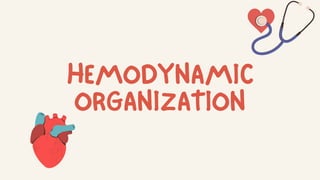
8Hemodynamic organization.pdf
- 3. Video Video
- 4. MAIN HEMODYNAMIC INDICATORS OF THE HEART systolic blood volume (SBV) minute volume of blood (MBV). The cardiac parameters are:
- 5. SBV SBV MBV MBV the amount of blood that is ejected into the main vessels by the ventricles of the heart in one systole (normally 60-80 ml) is the amount of blood that is ejected by the ventricles of the heart into the main vessels in one minute: MBV= SBV x HR(normally 4-5 l/min) HR- heart rate
- 6. To level anthropometric data one can use the cardiac index (CI - the ratio of the MBV to the body surface - S) and the SYSTOLIC index (Syst.I - the ratio of the SBV to S): CI=MBV/S Syst.I=SBV/S
- 8. Heart sounds Heart sounds Sound vibrations (heart sounds) that occur during one cardiac cycle can be heard this is called auscultation or recorded - a phonocardiogram (PCG) During auscultation only two tones can be heard: 1 (appearing during systole -systolic tone) II (occurring during diastole - diastolic tone).
- 9. Video Video
- 10. auscultation auscultation The best place to listen to the first tone is the 5th intercostal space to the left 1.5-2 cm medially from the midclavicular line (closing of the bicuspid valve) and at the base of the xiphoid process (closing of the tricuspid valve).
- 11. auscultation auscultation The best place to listen to the second sound is the second intercostal space on the right at the edge of the sternum (closing of the valves of the aorta) and in the second intercostal space on the left at the edge of the sternum (closing of the valves of the pulmonary artery).
- 12. auscultation auscultation In addition sound vibrations associated with the closure of the aortic semilunar valves can be heard on the left side of the sternum at the site of attachment III
- 13. what is it? what is it?
- 14. A phonocardiogram (or PCG) is a plot of high-fidelity recording of the sounds and murmurs made by the heart with the help of the machine called the phonocardiograph; thus, phonocardiography is the recording of all the sounds made by the heart during a cardiac cycle.
- 15. On PCG it is possible to note 4 tones: one systolic (I tone) and three diastolic (II III and IV tones).
- 16. I tone I tone consists of the following components: 1)the tension of the muscles of the ventricles and the tension of the tendon filaments of the leaflets; 2) closing of the valvular valves; 3) opening of the semilunar valves; 4) the dynamic effect of blood pumped from the ventricles and the vibration of the walls of the main vessels;
- 17. II and III tone II and III tone II tone occurs as a result closing of the semilunar valves; III tone occurs as a result of vibration of the walls of the ventricles in the phase of their rapid filling when the valvular valves are opened;
- 18. IV tone IV tone IV tone is associated with fluctuations in the walls of the ventricles in the phase of additional (active) filling due to atrial systole
- 20. Ventricular systole lasts 0.33 s. and consists of two phases and four periods. I. Tension phase- in this phase preparation of the ventricles for the performance of useful basic work pumping of blood from the ventricles of the heart into the main vessels occurs (0.07 - 0.08 s.) VENTRICULAR SYSTOLE
- 21. 1)the period of asynchronous contraction (0,04-0.05 s) - the entire ventricular myocardium is covered by excitation. During this period the valvular valves are open and the semilunar valves are closed;
- 22. 2) the period of isometric contraction (0.02-0.03 s) - starts from the moment that valvular valves become close. The contraction occurs in closed cavities during the period of isometric contraction .When the cavities of the ventricles are closed the tension of the myocardium increases, an increase in pressure occurs and when in the left ventricle it becomes equal to 70-80 mm Hg, and in the right - 12-15 mmHg. the semilunar valves of the aorta and pulmonary artery become open. From this moment begins the second phase of cardiac sycle
- 23. 1) the period of rapid ejection (0.12 s). At this time the pressure in the ventricles continues to increase - in the left ventricle up to 110-120 mm Hg and in the right - up to 25-30 mm Hg. II. PHASE OF BLOOD EJECTION
- 24. 2) the period of slow ejection (0.13-0.17 s). This period of ejection continues until the pressure in the cavities of the ventricles and in the main vessels become equal. II. PHASE OF BLOOD EJECTION
- 25. begins from the moment of cessation of ejection (pressure in the ventricles corresponds to the pressure in the main vessels). At the same time the semilunar valves had not yet closed but the ejection had ceased. VENTRICULAR DIASTOLE
- 26. DIASTOLE CONSISTS OF: Proto-diastolic period Isometric relaxation Phase of ventricular filling
- 27. 1. Proto-diastolic period (0.015-0.02c) - time from the end of blood ejection till the semilunar valves closing. 2. Isometric relaxation (0.08s) - the time from the closing of the semilunar valves to the opening of the valvular valves. At the same time relaxation of the ventricular myocardium occurs within closed cavities (valvular and semilunar valves are both closed).
- 28. 3. Phase of ventricular filling (0,35s) - the time from the opening of the valvular valves to the beginning of ventricular systole. This phase consists of three periods: a) period of rapid passive filling (0.08 s); b) the period of slow passive filling (0.17 s). c) the period of active filling of the ventricles carried out by atrial systole (0.1 s)
- 29. THANK YOU